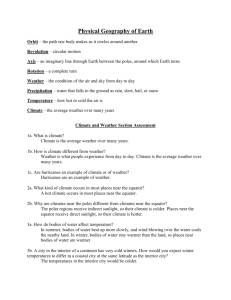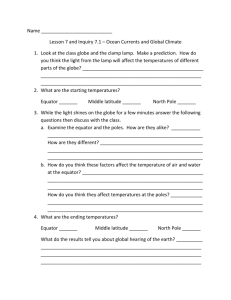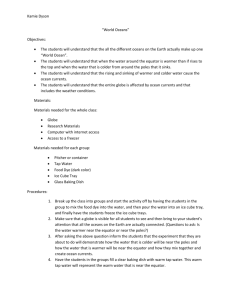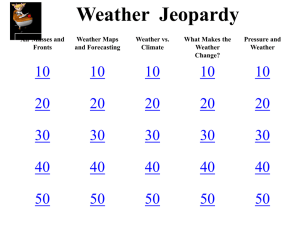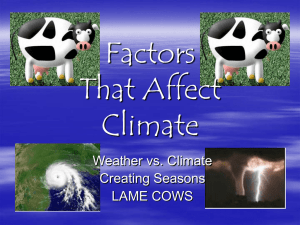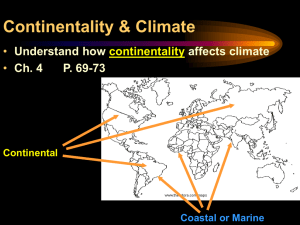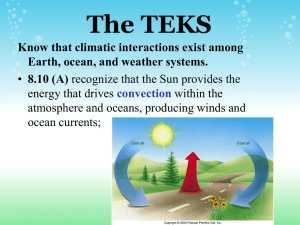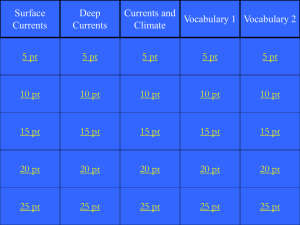Ocean Current and Climate Change
advertisement
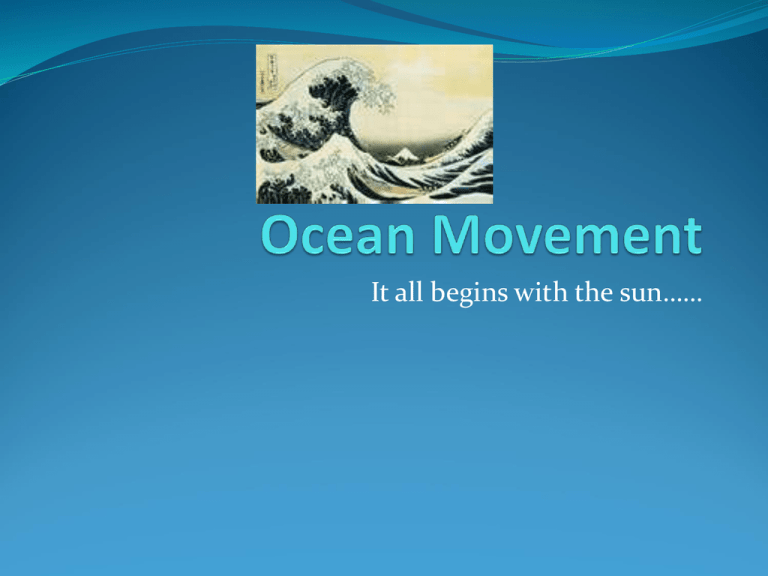
It all begins with the sun…… Uneven Heating of the Earth The Sun - The Earth's major source of energy The Earth is constantly receiving solar energy, but different areas of Earth receive different amounts of solar energy. This affects weather and climate. Different areas of the Earth receive different amounts of sunlight. The equator receives the most sunlight because the Sun is closer to being directly overhead year-round than it is at any other place on the Earth. This increases the amount of heat energy received and explains why areas near the equator have tropical climates. The poles receive the least sunlight, which is why they have cold climates. The solar energy received by the Earth causes ocean currents, winds, seasons, and climate differences. OCEAN CURRENTS The uneven heating of the Earth's surface creates energy flow. Winds and ocean currents flow from warmer areas to colder areas, which means that they travel from the equator toward the poles. Because water has a much higher heat capacity (absorbs and lets go of heat more) slowly than land, water temperature will increase and decrease less than land temperature. For example, during daytime, land temperatures might change by tens of degrees, while water temperature change by less than half a degree. This means that coastal land temperatures don’t fluctuate (go up and down) extremely (a lot) because the ocean water nearby doesn’t fluctuate much. •Upwelling Causes cold, nutrient rich water from the deep ocean to rise to the surface. El Nino and La Nina El Nino is a change in water temperature in the Pacific ocean that produces a warm current. La Nina is a change in temperature in the Eastern Pacific that causes surface water temperature to be much colder than usual BOTH El nino and La Nina can cause flooding (too much rain) and drought (too little rain) in different places on Earth. Upwelling does not occur where it normally would and this affects fish and sealife. Coriolis Effect Because of the Coriolis Effect, winds appear to deflected to the east or west depending on the direction winds are traveling. Uneven distribution of sun’s energy Current movements Deep water wave Coriolis Effect Relationship between Atlantic Thermohaline Circulation and Global Warming Result of Global Warming: Significant slowing of the ocean circulation that transfers warm water to the North Atlantic Ocean The southern hemisphere would become warmer and the northern hemisphere would become colder Why? Higher temperatures under global warming Increasing the precipitation, melting nearby sea ice, mountain glaciers and the Greenland ice sheet Add fresh water to the northern oceans The influx of fresh water reduce the surface salinity and density Dense water then sinks and slowly travels through the deep water southward into the Southern Hemisphere Lead to the significant slowing of the thermohaline circulation The North Atlantic Sink Impacts of ocean current slow down Distinct regional variability Bitter winters as Little Ice Age 17th-19th centuries possibly related to changes in the strength of North Atlantic thermohaline circulation 10,000 years ago, a period called ‘Younger Dryas’ caused European temperature dropped >10C The Day After Tomorrow? Solution The Framework Convention on Climate Change (UNFCCC) – Stabilizing Greenhouse Gases (1994) International Cooperation : Kyoto Protocol (1997); USA rejected Produce less green house gases, e.g. CO2 , Methane China`s responsibility 1. Regions at different latitudes around the world receive different amounts of solar radiation. Polar regions receive the least amount of solar radiation, while the equator receives the most. How does this most likely affect the global climate? A. polar regions experience colder climates B. the global climate is mostly cold C. the global climate is mostly warm D. equatorial regions experience colder climates 2. Seasonal changes in water temperature tend to remain within a narrow range. This is opposed to air temperature, which tends to fluctuate across a wide range. The relative stability of ocean temperatures helps to regulate the temperatures of coastal regions. Why can water remain within a narrow range of temperatures? A. It has a high heat capacity. B. It is mobile and this allows heated water to sink. C. It reflects heat and does not absorb heat. D. It is only stable within a small temperature range. 3. Convection currents, resulting from uneven heating of the Earth's surface, cause _________ to form. A. wind B. mountains C. volcanoes D. fossils 4. Ocean currents and global wind patterns, which are caused by convection currents, most strongly affect a region's... A. latitude. B. population size. C. day length. D. climate. 5. Water is cooler near the poles and warmer near the equator. Movement of cooler and warmer water from these regions moderates the global climate. Which of the following describes the movement of water between the poles and the equator? A. tides B. ocean currents C. evaporation D. gravity 6. Which property of oceans best explains why they have a major effect on climate? A. They contain large amounts of dissolved salt. B. They have a constant tidal movement. C. They absorb gases from the atmosphere. D. They hold a large amount of heat energy. 1. Regions at different latitudes around the world receive different amounts of solar radiation. Polar regions receive the least amount of solar radiation, while the equator receives the most. How does this most likely affect the global climate? Answer: A. polar regions experience colder climates 2. Seasonal changes in water temperature tend to remain within a narrow range. This is opposed to air temperature, which tends to fluctuate across a wide range. The relative stability of ocean temperatures helps to regulate the temperatures of coastal regions. Why can water remain within a narrow range of temperatures? A. It has a high heat capacity. 3. Convection currents, resulting from uneven heating of the Earth's surface, cause _________ to form. A. wind 4. Ocean currents and global wind patterns, which are caused by convection currents, most strongly affect a region's... Answer: D. climate. 5. Water is cooler near the poles and warmer near the equator. Movement of cooler and warmer water from these regions moderates the global climate. Which of the following describes the movement of water between the poles and the equator? Answer: B. ocean currents 6. Which property of oceans best explains why they have a major effect on climate? Answer: D. They hold a large amount of heat energy.
